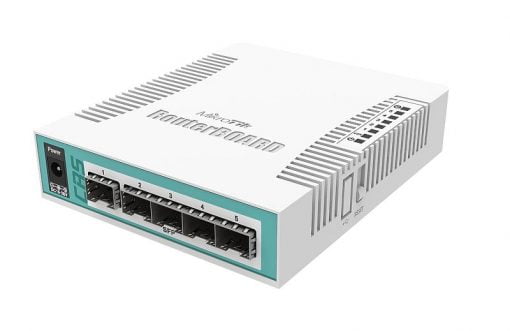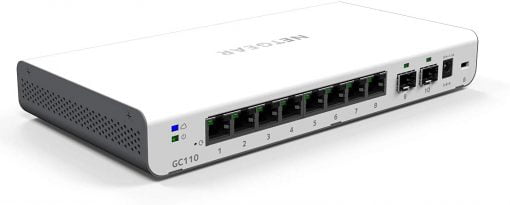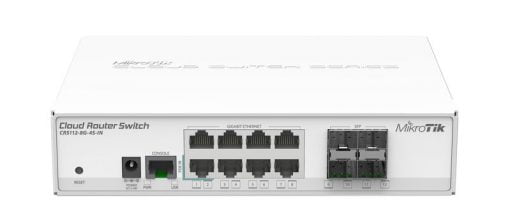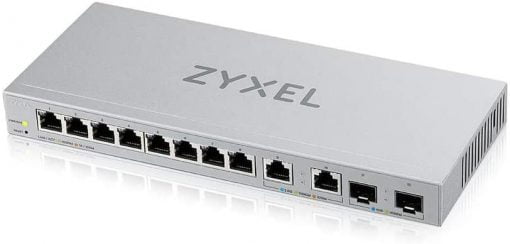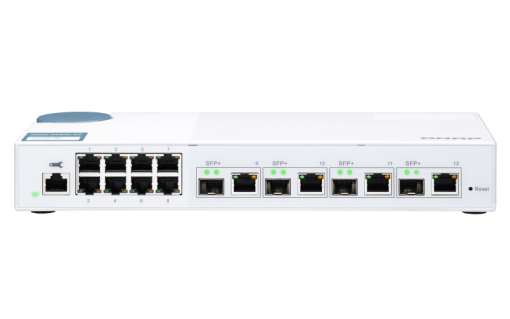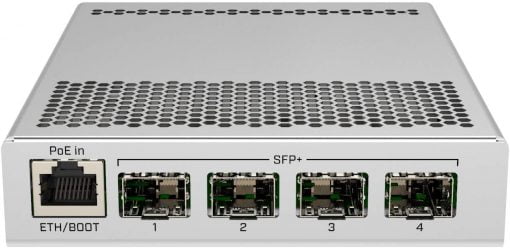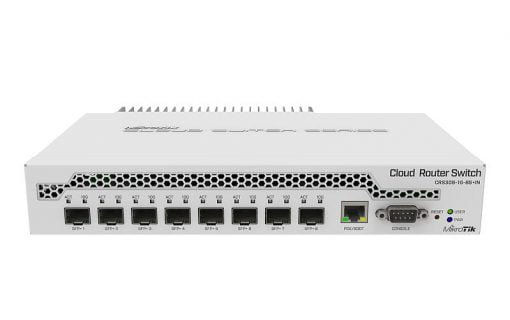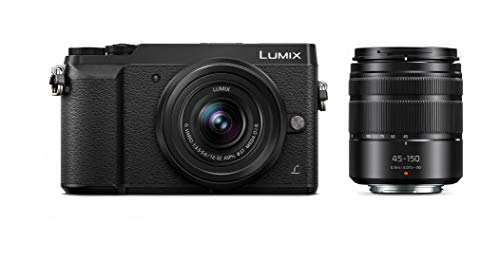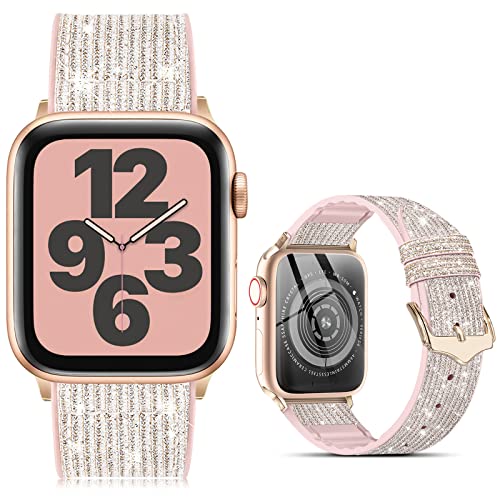Necessary hardware for fiber optics and 10 Gbit/s Ethernet
The thick network connectors in RJ45 format have been around forever. First the cables could transfer 10 Mbit/s, then 100, then 1 Gbit/s and now 10 Gbit/s. In the course of this development, fiber optic cables were added, which can also transmit 1 Gbit/s and 10 Gbit/s. If they are a bit slower than the SFP standard, they are faster than the SFP+ standard (look for the plus). So you can also use fiber optic for your internal cabling without having to increase the speed by force. Fiber has the advantage that it uses less power than copper cables, sending light signals seems to be much more efficient than pushing electrons through the cable.
If you buy a SFP/SFP+ switch, you have to take care that you only get the switch that has slots for the SFP modules. This increases the costs a bit, but also makes you more flexible. These modules are available from different manufacturers and if you have a good switch, for example from MikroTik, it will also work with third party modules. But it may well be that a Cisco switch only works with Cisco modules.
Furthermore you have to check if a RJ45 SFP module maps the speed the connected device needs. 10 Gbps they all can, but the intermediate speeds used by some devices, i.e. 2.5 or 5 Gbps, do not all work. So check that beforehand if your device depends on it.
Entry-level fiber SFP Switches for 1 Gbit/s transmission (1 to 4 SFP ports)
Should one rely on fiber optics at 1 Gbit/s speed and why? We think so, especially if you are currently rewiring. Then you can do the effort once and lay a modern fiber optic cable. But you are not obliged to buy the most expensive switches and 10 Gbit/s SFP+ modules. You can also do without pure SFP switches.
So first of all, focus on the cable that causes the most effort. If you decide to leave everything at 1 Gbit and wait, that’s a good decision (especially if you really only want to distribute Internet and only use the NAS from time to time). This way everything stays cheap and the power consumption is low. The switches that understand SFP at least once cost around 50 and the 1 Gbit modules around ten Euros.
Mikrotik RB260GS 5-Port Switch with SFP Cage
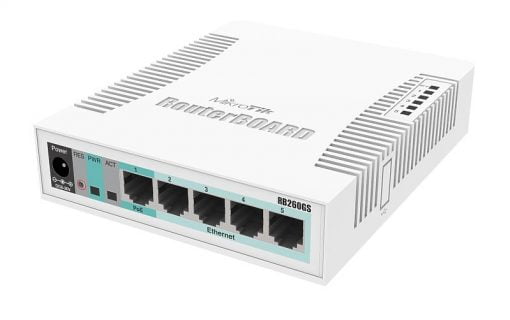
The small microtik switch offers five conventional Gigabit ports and an SFP cage for a 1 Gigabit SFP module. So you can switch to fiber optics at low cost without incurring any expenses. The whole switch costs just over 40 Euro.
And it is managed! On board is Mikrotik’s RouterOS, an easy to use version of the router operating system RouterOS. With it you can set everything a switch has to be able to do. This model does the splits if you are looking for the cheapest and one of the most powerful managed switches. The fact that it also offers a SFP cage on the backside is listed here.
The model Mikrotik RB260GSP (P for power) is for you if you need PoE support.
Buy Mikrotik RB260GS: Amazon
Buy Mikrotik RB260GSP PoE: Amazon
Mikrotik CRS106-1C-5S 6-Port SFP Switch with RJ45 Combo Port
You are totally convinced of fiber optics and only need 1 Gbit/s? Then the CRS106-1C-5S is for you: There are five cages for SFP modules as well as a combo port, which you can use either as another SFP port or as a normal RJ45 connector. All this is available for about 50 Euro.
In this variant there is also the full-blown RouterOS (which can be switched to SwitchOS for easier use), which really can do everything. Although the hardware is designed for switch activities and if you need a main router you should look elsewhere, but it is always nice to know that you have the full choice.
Buy Mikrotik CRS106-1C-5S: Amazon
Netgear GC110 10-Port Gigabit Smart Cloud Switch
This Netgear switch isn’t for everyone: it provides cloud connectivity so it can be controlled from Netgear’s cloud. So you’re in control even when you’re not on site.
The switch offers you eight Gigabit RJ45 jacks and two cages for SFP 1 Gbps modules. The model is available also as a PoE model.
Buy Netgear GC110: Amazon

| Availability | In Stock. |

| Availability | In Stock. |

| Availability | In Stock. |
![ZyXEL 8-Port Gigabit Ethernet Smart Managed PoE Switch with 77 Watt Budget - Fanless Design and 2 SFP Ports [GS1900-10HP], Black, 77W PoE+](https://m.media-amazon.com/images/I/41gVsJAcdZL._SL160_.jpg)
| Availability | In Stock. |

| Availability | In Stock. |

| Availability | In Stock. |
Zyxel SFP 8-Port Power-over-Ethernet Switch GS1900-10HP
Would you like a few more ports that also come with PoE support and two additional SFP ports? Then take a look at the Zyxel GS1900-10HP. You get Power-over-Ethernet support for eight ports for a total of 77 watts. It’s also a managed switch, so you can set up things VLANs the way you want.
Buy Zyxel GS1900-10HP: Amazon
Netgear GS324T 24-Port Gigabit Ethernet LAN Switch with 2x SFP

You want ports all the way? Then the Netgear GS325T offers you 24 Gigabit Ethernet ports. For the connection to modern hardware there are 2x SFP on top (no SFP+). Furthermore the switch is managed and comes with a 30 year warranty (you can’t say more in Germany ;)). So keep the bill well. If you need PoE for a lot of surveillance cameras, use the powered version, which can deliver up to 190 watts.
Buy Zyxel GS1900-10HP: Amazon
Mikrotik CRS112-8G-4S-IN LAN Switch with 4x SFP
Fine, you want more SFP ports. Then this inexpensive Microtik CRS112-8G-4S-IN switch might be something for your purpose. There are four SFP cages and nine copper-based gigabit ports. There is also a complete RouterOS as operating system on board.
But please don’t make the mistake of using the device as a router – the performance is not good enough. It’s ok to try, but please consider it as a switch – then it’s an excellent device at a reasonable price.
There is also a variant with only one SFP cage but WLAN, the CRS109-8G-1S-2HND-IN, as well as the PoE variant CRS112-8P-4S-IN (again, keep in mind the limited processing power if you don’t want to limit yourself to switch tasks).
Buy Mikrotik CRS112-8G-4S-IN: Amazon
2.5, 5 and 10 Gbps switches offering copper-based RJ45 ports only
You plan to leave everything on copper, but increase the speed? Why not, we have already explained the advantages and disadvantages above. So here are the models that come into question for a pure RJ45 network:
Qnap QSW-1105-5T 5 Port 2.5 Gbps Switch

The smallest switch offering more than 1 Gigabit per second on all ports is the Qnap QSW-1105-5T. This model offers 2.5 Gbps and is intended for low-cost network installations (as soon as it is not quite as new and the price drops). Maybe it will become so cheap that it will soon no longer be worth buying 1 Gigabit switch at all. For many applications at home, 250 MB/s should be enough to make good use of a NAS with two hard drives.
Buy Qnap QSW-1105-5T: not yet available
Netgear GS110MX 10-Port 10 Gigabit Switch with 2x RJ45
The 2x RJ45 refers of course to the two 10 Gbit/s ports. Of course, the other Ethernet ports are also RJ45, but offer the conventional gigabit speed. Also included is Netgear’s long per warranty (cancel invoice!).
The switch is unmanaged, so plug in the cable and you’re done. An ideal solution if you only have a Mac with the fast network interface and maybe a corresponding NAS.
Buy Netgear GS110MX: Amazon
 |  |  |
| QNAP QSW-1105-5T 5-Port Unmanaged 2.5GbE Switch* | ASUS XG-U2008 Unmanaged 2-Port 10G, 8-Port Gigabit Switch* | NETGEAR 10-Port Gigabit/10G Ethernet Unmanaged Switch (GS110MX) - with 2 x 10G/Multi-gig, Desktop/Rackmount, and ProSAFE Limited Lifetime Protection* |
| In Stock. | In Stock. | |
| $ 139.00 Price incl. VAT., Excl. Shipping | $ 414.47 Price incl. VAT., Excl. Shipping | $ 199.94 Price incl. VAT., Excl. Shipping |
| Buy on Amazon* | Buy on Amazon* | Buy on Amazon* |

| Availability | In Stock. |

| Availability | In Stock. |
Asus XG-U2008 10-Port 10 Gigabit Switch with 2x RJ45
You want the same as above, but in a more stylish package? You are welcome: The Asus AG-U2008. Eight gigabit ports, two RJ45 10 Gbit versions. The switch has the habit of getting very warm despite the huge internal heat sink. So if you’re looking for a long life and don’t care so much about looks, you’d better go for Netgear.
Buy Asus XG-U2008: Amazon
Pure RJ45 10 Gbps switches with 1 or 2 SFP+ ports
These switches come into question for you if you have many Macs that need to connect to the net at high speed, but the net actually runs on SFP+. The switches shown here have many ports for 10 Gbit/s copper, but have fiber ports for one or two additional connections.
Netgear XS505M 5-Port 10 Gigabit Switch
The Netgear XS505M offers four full 10 Gbps ports for RJ45 copper cable, but does not neglect an SFP+ interface. A small full 10 Gb switch if the total of five ports is enough for your fastest devices.
Buy Netgear XS505M: Amazon
 |  |
| NETGEAR 5-Port 10G Multi-Gigabit Ethernet Unmanaged Switch (XS505M) - with 1 x 10G SFP+, Desktop/Rackmount, and ProSAFE Limited Lifetime Protection* | NETGEAR 8-Port 10G Multi-Gigabit Ethernet Unmanaged Switch (XS508M) - with 1 x 10G SFP+, Desktop/Rackmount, and ProSAFE Limited Lifetime Protection* |
| In Stock. | In Stock. |
| $ 399.99 Price incl. VAT., Excl. Shipping | $ 599.98 Price incl. VAT., Excl. Shipping |
| Buy on Amazon* | Buy on Amazon* |

| Availability | In Stock. |

| Availability | In Stock. |
Netgear XS508M 8-Port 10 Gigabit Switch
If you need more connections, the Netgear XS508M is the best choice. There are eight 10 Gbit ports and one SFP+ variant. In addition, the switch is available both managed and unmanaged (approx. 100 Euro difference).
But there is still more to come in Netgear’s portfolio: If you follow the affiliate link you will also find copies with 10, 12, 16, 24, 28, 48 and 52 ports, some models also with PoE support.
Buy Netgear XS508M: Amazon
switches with 1 – 10 Gbit/s RJ45 copper and SFP+ fiber ports
Zyxel XGS1010-12 12-Port Switch 2x 2.5 Gbit/s RJ45 2x SFP+
The Zyxel is one of the best switches you can buy for home and office use. The best thing first: it does not need a fan. So you get a great speed without any noise annoying you.
Two SFP+ ports connect the device to the 10 GBit/s network via fiber. In addition, two devices can be connected via conventional RJ45 ports with a maximum of 2.5 GBit/s. This is not the maximum, but for many Macs this is a significant increase. You will be two and a half times faster in your home network and should be able to use a hard disk NAS to its full capacity. So this switch is also a good balance between price and performance because of its price.
The device also comes with 12 ports in total, because of course there are also eight 1 Gbit/s ports on board. The entire existing infrastructure, which does not need to be accelerated, can be connected immediately. Two ports are even equipped with a QoS function – the connected devices are treated as preferred. Our top tip.
Buy Zyxel XGS1010-12: Amazon
Qnap QSW-308-1C unmanaged switch 1x RJ45 3x SFP+
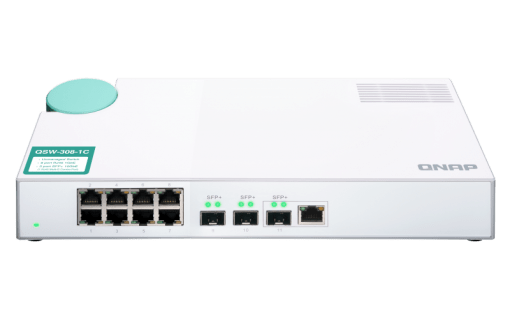
If you only have a Mac that you want to connect to a fast network via RJ45 port, the Qnap QSW-308-1C might be a good choice. This model offers not only this fast port with 10 GBit/s but also three SFP+ ports. Ideal if all your other fast devices are based on fiber optics.
Additionally there are eight conventional gigabit ports for everything else. The switch is unmanaged.
Buy Qnap QSW-308-1C: Amazon
Qnap QSW-804-4C 8-port and QSW-1208-8C 12 port mixed switches
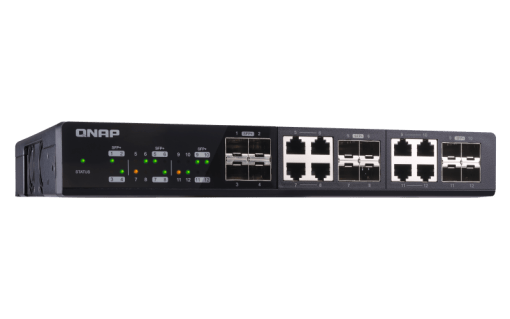
Also unmanaged, but with significantly more ports, the Qnap models in black are presented. Each of them offers four fixed SFP+ ports that support 10 Gbit/s transfer. The smaller modele also offers another four RJ45 and SFP+ ports, four of which can be used in total (so you always have to choose between RJ45 or SFP+ standard per port – the 10 Gbps are always available). The larger model offers this choice with
16 other ports, of which a maximum of eight can be used in the same way (i.e. eight times RJ45 only or eight times SFP+ or any combination in between).
These devices are ideal when many interfaces are required, flexibility between RJ45 and SFP+ is a must and full 10 Gbps should be available on all ports. Both devices are unmanaged, this should be mentioned. A fan is also on board.
Qnap QSW-804-4C: Amazon
Qnap QSW-1208-8C: Amazon
![Zyxel Multi-Gig 12-Port Unmanaged Switch with 2-Port 2 5G and 2-Port 10G SFP+ Desktop/Wallmount, 5-Years Warranty [XGS1010-12]](https://m.media-amazon.com/images/I/314jvZ79rUL._SL160_.jpg)
| Availability | In Stock. |

| Availability | In Stock. |

| Availability | In Stock. |

| Availability | In Stock. |

| Availability | Usually ships within 3 to 5 weeks. |

| Availability | In Stock. |
Qnap QSW-M408-2C managed Switch 2x SFP+ 2x RJ45/SFP+
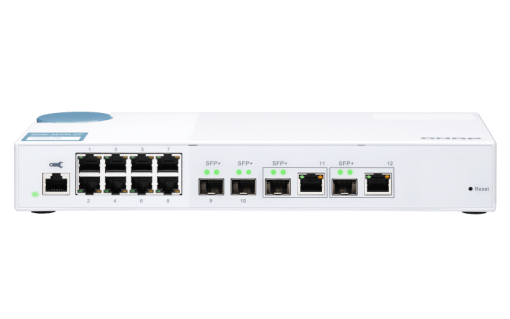
The Qnap QSW-M408-2C is a managed switch that gives you control over your network. It is similar to the unmanaged model mentioned above, but in addition to the control functions it has one more usable port (which can be used either as RJ45 or SFP+).
In addition, there are again eight conventional gigabit ports for everything else and one more Ethernet port for configuration.
Buy Qnap QSW-M408-2C: Amazon
Qnap QSW-M408-4C managed Switch 4x RJ45/SFP+
If you want full flexibility with a managed switch, the QSW-M408-4C is for you. Four times RJ45, four times SFP+, four of which can be used simultaneously as usual.
Plus eight conventional gigabit ports and one console.
Currently this model is hard to get (link points somewhere else then). It should be available from mid/end of September.
Buy Qnap QSW-M408-4C: Amazon
Switches with predominantly 10 Gbit/s SFP+ ports
If you have chosen fiber optics as a new medium for you, you will find a very good selection of switches that provide almost only SFP+ and SFP ports. This not only feels modern, but is also more power efficient (0.7 watts for a fiber port vs. 2-3 watts for a RJ45 port).
MikroTik CRS305-1G-4S+IN 4-Port 10 Gigabit Switch
The small Mikrotik CRS305-1G-4S+IN is a compact and affordable 10 Gbps switch if you need up to four SFP+ ports. As an extra there is also a conventional Gigabit port, which is also PoE-in compatible, so the switch can be operated without an extra power supply if the cabling is suitable.
A license for SwitchOS and RouterOS is also included, so there are hardly any limits to the settings of the managed switch. Since an RJ45 module can also be inserted into the model due to the SFP+ cages, fast copper-based networks can also be connected. However, since these modules cost between 60 and 70 Euros, it is sometimes almost more reasonable to buy a switch from the above category “Flexible Switches”, which already provide mixed connection types. But for pure SFP+ switching on a small scale the MikroTik is more than suitable and a great entry into the fiber optic world.
For example, you can start with 1 Gbit modules and later switch to the faster 10 Gbit variant. The switch also has two power connectors on the backside – a good thing if you want to use the switch somewhere inaccessible and want to have a redundant power supply.
Buy MikroTik CRS305-1G-4S+IN: Amazon
 |  |
| MikroTik 5-Port Desktop Switch, 1 Gigabit Ethernet Port, 4 SFP+ 10Gbps Ports (CRS305-1G-4S+IN)* | MikroTik 9-Port Desktop Switch, 1 Gigabit Ethernet Port, 8 SFP+ 10Gbps Ports (CRS309-1G-8S+IN)* |
| $ 143.88 Price incl. VAT., Excl. Shipping | Price not available Price incl. VAT., Excl. Shipping |
| Buy on Amazon* | Buy on Amazon* |


MikroTik CRS309-1G-8S+IN 8-Port 10 Gigabit Switch
You are already fully convinced of fiber optics and just want more ports? Then pick up the MikroTik CRS309-1G-8S+IN. Full 10 Gbit speed on all SFP+ ports, plus a normal gigabit port. Again with MikroTik’s excellent operating system.
The power consumption of around 20 watts is also acceptable for private households at the speeds offered.
Buy MikroTik CRS309-1G-8S+IN: Amazon
What do I do if I have a device with 10 Gbit/s RJ45 jack but want to use fiber SFP+?
There may be a situation where you want to switch to fiber optics for new fast devices and simply leave the others (older computers, network cameras, TVs, phones, etc.) on 1 Gbps copper. A smart plan. But now you may have bought a new Mac Pro or Mac mini that has a 10 Gbps port – for the old copper lines. It would have been better if Apple had simply given the devices the state of the art: an SFP+ cage. These are basically just the sockets into which the actual data transformer still has to be plugged. Yes, you have to buy this one extra, but these parts are not that expensive and offer a decisive advantage: You can choose between an SFP (1 Gbit/s) variant, an SFP+ (10 Gbit/s) variant or an RJ45 (10 Gbit/s for copper). You make your fiber optic switch copper-compatible, so to speak. And this is the smartest and in most cases the most economical variant. So you have to connect the Macs using old-fashioned copper cable and the signal is then processed in the appropriate SFP+ RJ45 for the switch. All other devices can stay on fiber – the SFP cages make this flexible.
An alternative option would be to purchase a switch that supports both RJ45 and SFP+ in 10 Gbps each. These are available, but they are comparatively expensive. Or you could use an adapter to convert the signal from copper to fiber directly on the Mac, but that doesn’t look good and is only necessary if you have only fiber optic cables. It would have been more practical if Apple had made SFP+ modules possible like all the others or maybe even integrated a fiber optic connection right away. But this way you could probably have had breakfast with the backward compatibility with older networks. So you just have to accept the slightly higher power consumption – and what would a Mac be without an adapter 😉
Should I now dispose of all my 100 Mbit/s and 1 Gbit/s switches and hardware?
Not at all. It makes sense to sort the devices by groups (if the geographical conditions are natural). For example, you can use an old router as an access point for the guest WLAN and then connect devices like the TV, Zigbee Bridges for Hue or Ikea lamps, telephones, internet radios etc. to the 100 Mbit/s ports. So everything where speed is not important. This procedure has a big advantage: old switches are usually slow, but also very economical and should consume between two and three watts. So you save a new purchase and also energy.
You can go through the devices that are now in your network with 1 Gbit/s one by one: Is it so important that they reach 10 Gbit/s? The work computer, from which the videos are backed up over the network, of course, as well as the NAS hanging on the other side. But the office computer too? Or the Playstation? Based on these considerations, you can then roughly develop a structure of what kind of switches (or switches? switch devices maybe) you need.
The following scenarios are possible:
.
In principle, there is no longer any reason not to use fiber optics for new cabling. The cables are cheap and should remain state of the art until there is something faster than light. You don’t have to go directly to 10 Gbit/s, 1 Gbit/s is also possible, sometimes it is a bit cheaper, often it makes no difference. It depends on the switch you have in mind.
Hardware that stays on copper, like the Macs or sometimes cheaper NAS devices that offer 2.5 Gbps RJ45 jacks, forces you to buy relatively expensive copper switches. Check again if it is not cheaper to buy a SFP+-only switch and just buy the RJ45 SFP modules. Maybe with one or two exceptions it is enough to leave them at 1 Gbit/s, so that the switches do not become too expensive and the power consumption does not increase even more.
10 Gbit/s Ethernet: RJ45 copper vs. SFP+ fiber optics
In addition, the copper variant also offers intermediate stages: for example, there are also 2.5 Gbit/s and 5 Gbit/s, which are intended to make the corresponding technology cheaper. However, it has just become clear that at least 10 Gbit/s via copper is more expensive than via fiber optics, and that in two areas: On the one hand, the available switches are expensive and hardly affordable for home use, or only have one or two upstream ports. Secondly, 10 Gbit/s technology on copper requires significantly more power than the fiber optic variant. Using the old copper cabling works, but is actually outdated for these speeds. You have to, if you should go for 10 Gbit/s and depend on copper, for example because your whole company is wired this way, expect a much higher power consumption. If you have the chance at home to replace the existing cables (at least those that depend on 10 Gbit/s speed), you should do so. The fiber optic cables themselves are not that expensive and SFP+ switches are much cheaper than the RJ45 variants for copper.
